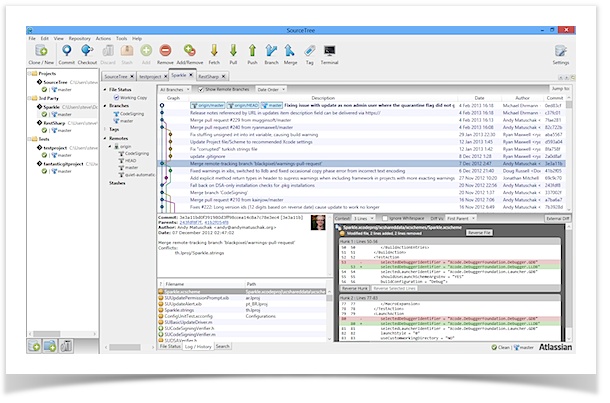
A "toggle -ignore-space-changes" command would help here.

Git only offers -ignore-space-changes but not -only-space-changes.It might be a bit inconvenient that this requires two steps, but.It might be necessary to also force -unidiff-zero to be used.That isn't accurate and also not relevant here. One can select and move commits with intuitive gestures. GitUp is a visual editor for repos, branches, and commits. apply is already always called with -ignore-space-change. It's a radical departure from the other apps which all more-or-less just throw all the git actions into menus.That only works if you work on the sub-file level.Enable -ignore-space-changes and put it into effect using g.

In the status buffer press D to enter the "change diff arguments used in this buffer" popup.That already exists but is more centered around diff than apply. I hope that better illustrates the feature that I think would be really cool.Īs I mentioned, a generalized whitespace "mask" for apply operations could be more broadly useful/powerful. Step 2: Clone it locally Open SourceTree and switch to Remote. Ex: C-u S to stage all non-whitespace changes, C-u C-u s to stage all whitespace changes according to the current point (ex: within a file, hunk, or region), or C-u C-u U to unstage all whitespace changes. Go to Bitbucket and click on the + icon to create a new repository. It's not necessarily a good idea for implementation of this hypothetical feature, but I can imagine for example using a prefix command with the existing apply commands. I currently use git diff -U0 -w -no-color | git apply -cached -ignore-whitespace -unidiff-zero - ( original source) to isolate non-whitespace changes when staging. The whitespace mistakes could be isolated and corrected in a commit without needing to stash or discard changes to code.
Sourcetree discard code#
If the unmodified file has trailing whitespace on a line and I deleted it while reading through the code and making changes I want to be able to unstage/discard that and any other whitespace changes I made en-masse so that my commit does not include extraneous line modifications.Īs I mentioned, a generalized whitespace "mask" for apply operations could be more broadly useful/powerful. What whitespace-cleanup regards as correct may frequently be different from the form of whitespace of the unmodified file. I want to preserve whitespace mistakes if they already exist. My intent, however is to regard the git version as authoritative/correct. hg commit creates a snapshot of the changes to 1 or more files in the local repository.Thanks for the suggestions. Files are stored in a project’s working directory (which users see), and the local repository (where committed snapshots are permanently recorded). Hg status shows the status of a repository. This is useful for cleaning up in-source builds. Hg purge –all will delete all un-tracked and ignored files. You typically use hg revert when you decide that you don’t want to keep the uncommited changes you’ve made to a file in your working copy. Hg revert changes the file content only and leaves the working copy parent revision alone. Mercurial groups all changes from one hg pull into a single transaction, so one hg rollback is all you need to undo this mistake. You can visualize changes to decide what to discard or what to commit by the file, hunk, or even line by line.
Sourcetree discard free#
Simplify Your Development Workflows from Your Desktop With all the features you expect from Git, Sourcetree isn’t just a free GUI for viewing your repositories. The hg rollback command will work nicely to expunge all of the changesets that you just pulled. Sourcetree also simplifies your distributed version control tasks. The commit with the changes you negated will still exist. This will effectively create a new commit that negates the changes you made in your selected commit. Get an overview of version control and the role that Sourcetree plays. What exactly do you mean by revert? You can commit a reverse commit by rightclicking on a commit and selecting Reverse commit. See some of the major parts of the SourceTree interface. Discard Hunk means remove the change without trace. Git : Stage Hunk and Discard Hunk (SourceTree) Stage hunk means it is being added to the staging area. Backout works by applying a changeset that’s the opposite of the changeset to be backed out….Backout is basically four steps rolled into one:


 0 kommentar(er)
0 kommentar(er)
